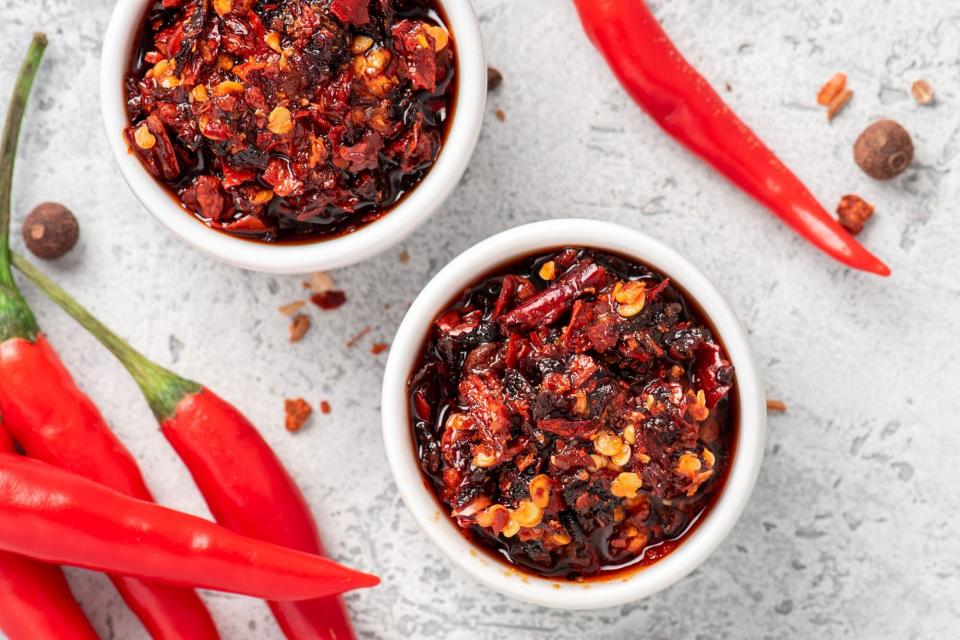Homemade Chile Oil Is the Condiment You'll Want to Add to Everything
It's no surprise that this bright red peppery condiment finally has its spot in the limelight. Spicy sauces and oils enliven food, and it seems like everyone is always looking for more to add to their pantry. The chile (or chili) oil trend is inspired by Sichuan chile oil, a staple from the southwestern Chinese region of Sichuan, and it's one you can try at home: Sizzling chiles in heated oil to create a flavorful condiment is a versatile technique embraced by many cultures, and it's so simple to try.

getty images / Svetlana Monyakova
Follow our guide to selecting chile flakes and making the condiment, then try our flavorful ideas for using chile oil in your own cooking. This fragrant, spicy, and nutty condiment can literally be spooned onto any savory dish to add kick and crunch.
Related: Cooking Oils and How to Use Them
Choosing Chile Flakes
The heart of the recipe is the red chile flake—Sichuan chile oil is made with Sichuan chile flakes, and while hey are a great place to start at home, know that you can also adjust the flavor of chile oil by making it with different flakes such as gochugaru (Korean chile flakes), Aleppo pepper flakes, Urfa Biber flakes, or Italian red pepper flakes. Another option is to use whole dried chiles, first toasting and seeding them before grinding them up into flakes. For this we love the fiery chile de arbol or guajillo chiles, which are often used in a smoky Mexican chile oil called salsa macha.
While the oil tones down the heat, if you use a hot chile flake, you should expect a hot chile oil; if you use a smoky chile, you should expect a smoky chile oil. Chiles have varying heat levels, take that into account when deciding how much to add.
How to Make Chile Oil
First, get ready to sizzle: Prep the chile flakes by placing them in a heatproof bowl and mixing in any aromatics. Factor in about ¼ cup to ½ cup of chile flakes for around one cup of oil, adjusting based on heat preference and the chile's spice level. If you like crispy bits in the oil, what's called "crunch," stir minced garlic, shallots, scallion, or ginger into the chile flakes now. These same ingredients can alternatively be added into the oil in the next step and strained out for a smoother oil. Set the bowl aside.
Next, you'll warm and infuse the oil. To do this, pour a neutral oil (such as grapeseed, canola, or safflower) into a small saucepan and heat until it is hot and just starting to shimmer. If the oil gets too hot, let it cool off slightly to prevent the chiles from burning which creates bitter notes. It's sufficient to use just chile flakes and oil, however for a more complex condiment try layering in additional flavor by infusing the oil with aromatics as it heats. Let the oil and aromatics heat together for a few minutes at a bare simmer. For a fiery (but not hot) bite add garlic, shallot, or ginger. For an element of spice, add a cinnamon stick, cardamom pods, star anise, fennel seeds, bay leaves, or cumin seed. For a tingly mouthfeel, add Sichuan peppercorns. While all these aromatics sound great, starting with no more than three or four different aromatics rather than throwing them all in.
Now, you'll pour the oil over the flakes. If you infused the oil with aromatics, place a fine mesh sieve over the prepared bowl of chile flakes. If you opted for just oil, no need to use the strainer. Either way, be sure to carefully pour the hot oil over the chile flakes—the flakes should sizzle as the oil hits them, which is the sign that the oil is sufficiently heated and they are toasting. Discard any solids from the strainer, then let the mixture infuse while it cools to room temperature.
Last but not least, be sure to season the chile oil. This optional step is the last opportunity you have to pack in flavor. We suggest seasoning the oil with salt or salty umami packed soy sauce or fish sauce, or else stirring in a touch of sugar to add a savory-sweet element. Toasted sesame seeds or chopped nuts, like roasted peanuts, infuse the condiment with nuttiness and an extra crunch. Drizzle in some toasted sesame oil or tart vinegar. There's lots of room for experimentation so try a few variations to come up with your favorite.
You should store your homemade chile oil in an airtight jar in the refrigerator.
How to Use Chile Oil
We say use your homemade chile oil liberally and often! Dollop it on quick and easy dinners such as noodle dishes, soups, stir-fries, fried rice, tacos, and so much more. Fry eggs in the chile oil for breakfast and serve with the contrast of cooling yogurt. Combine chile oil with tahini or yogurt and spooning this sauce over cooked vegetables or meat for an instant upgrade. Any dish that could benefit from an oomph of flavor and a little heat is a candidate for chile oil. And don't stop at savory: Some people enjoy chile oil over vanilla ice cream.

